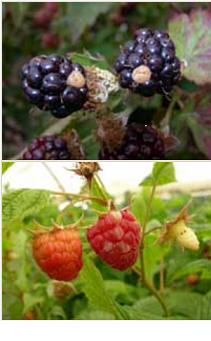Advice for the Home Gardener from the Home Gardener from the
Help Desk of the UC Master Gardener Program of Contra Costa County

With White Drupelet Disorder
Help Desk Response: Thanks for contacting the UC Master Gardener Program Help Desk with your question about the “white spots” on your blackberries.
What you see happening on the fruit of your blackberry vine is an abiotic disorder (damage not caused by insects or disease) called “White Drupelet”. A “drupelet" is the individual seed on fruits like blackberries and raspberries (the “bump”).
White Drupelet will appear as a tan-to-white discoloration on the drupelets of caneberry fruit, and it can effect one drupelet or many. As you have described, the drupelet's often appear brown and hard at first, then become soft and take on a tan-to-white coloration.
This disorder happens when there is a sharp increase in the heat and a drop in humidity, often caused by wind. This is exactly the weather pattern we have had lately -- lots of wind with high heat and low humidity. Although this condition is weather related, the actual cause of the “whitening” is UV radiation. Ordinarily, cool, humid air scatters and absorbs UV radiation, while hot, dry air has the opposite effect and allows more direct UV rays to reach the fruit. You may be observing this condition more in the canopy of the vine, or on the berries exposed to the sun, while the fruit tucked in under the leaves lower on the vine may be unaffected. When the heat subsides, and the humidity increases the condition will correct itself. The berries are safe to eat but you will want to remove the damaged part of the fruit. This UC Pest Note provides some more detailed information on White Drupelet disease: http://ipm.ucanr.edu/PMG/r71800111.html.
There is some debate about shade cloth being used to protect the vines but we found no conclusive scientific information indicating that shade cloth will prevent this condition.
If you were to experiment using shade cloth you must be careful to leave a good space between the shade cloth and the vine for proper air circulation or the shade cloth will just exacerbate the problem, creating more of a greenhouse effect rather than a shade structure.
Note: If you were to see the pale colored drupelets ONLY on the back side of the fruit (away from the sun) this could be caused by thrips, red mites or stinkbugs. More information on growing caneberries can be found searching for “caneberries” at http://ipm.ucanr.edu/GENERAL/search.html
Thanks for contacting the Master Gardener Program with your question. If we can be of further help, don't hesitate to contact us.
Help Desk of the UC Master Gardener Program of Contra Costa County (BHD)
Note: The UC Master Gardeners Program of Contra Costa's Help Desk is available year-round to answer your gardening questions. Except for a few holidays, we're open every week, Monday through Thursday for walk-ins from 9:00 am to Noon at 75 Santa Barbara Road, 2d Floor, Pleasant Hill, CA 94523. We can also be reached via telephone: (925)646-6586, email: ccmg@ucanr.edu, or on the web at http://ccmg.ucanr.edu/Ask_Us/ MGCC Blogs can be found at http://ccmg.ucanr.edu/HortCoCo/ You can also subscribe to the Blog (//ucanr.edu/blogs/CCMGBlog/).